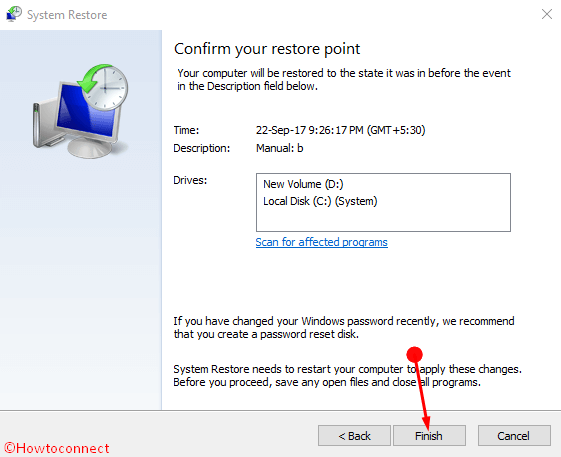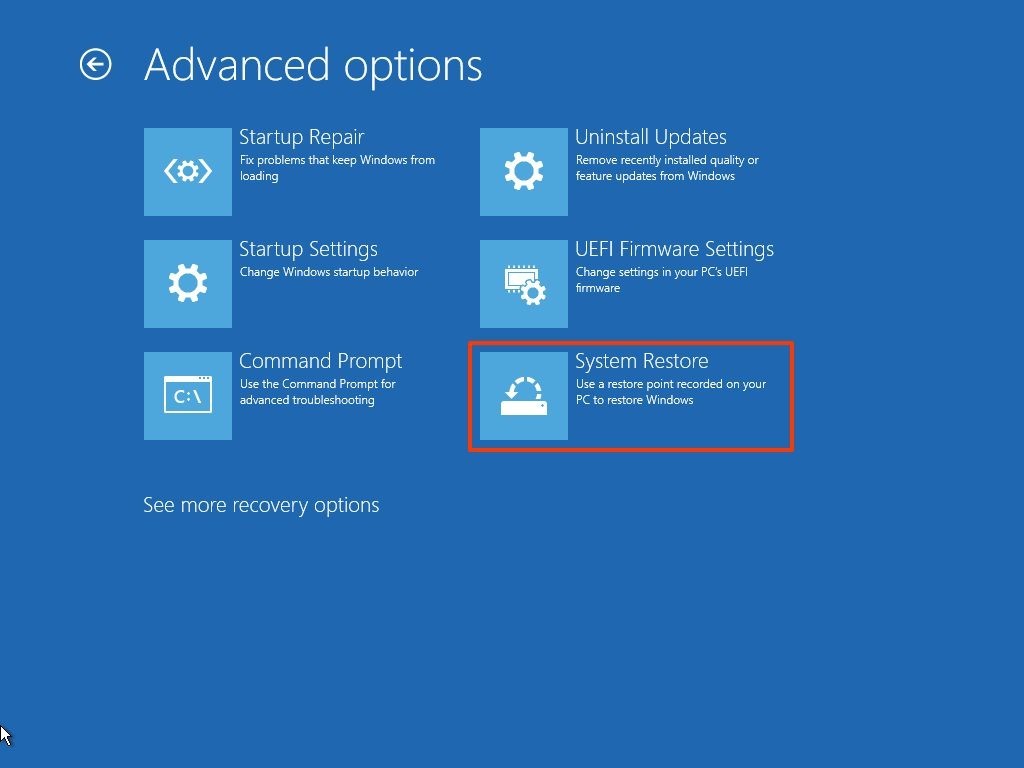
- SYSTEM RESTORE COMMAND PROMPT WINDOWS 10 HOW TO
- SYSTEM RESTORE COMMAND PROMPT WINDOWS 10 WINDOWS 10
- SYSTEM RESTORE COMMAND PROMPT WINDOWS 10 SOFTWARE
- SYSTEM RESTORE COMMAND PROMPT WINDOWS 10 FREE
To delete the system restore point, type the following command and press Enter. Locate the restore point you want to delete and copy its Shadow Copy ID.ģ.

You can identify each restore point by the creation time. This will display a list of all existing restore points on your computer, as shown in the figure below. Type vssadmin list shadows, and press Enter. This will open an elevated Command Prompt.Ģ. When Command Prompt appears in the search results, right-click it and select Run as administrator. Type cmd in the search box next to the Start button. We can also configure system restore service from. Step 2: Delete the system restore point with Command Prompt.ġ. We can enable or disable system restore from Windows command line by modifying the relevant registry keys. Note down the restore point you want to delete by its creation time and description. When the System Restore window opens, click Next and you can see a list of all existing restore points on your computer. Then go to Recovery > Open System Restore.Ģ. Open Control Panel and select to view by Large icons. Step 1: Check the system restore point you want to delete.ġ. If you want to selectively delete one of the many system restore points, you need to use the Command Prompt. Way 3: Delete an individual system restore point using CMD
SYSTEM RESTORE COMMAND PROMPT WINDOWS 10 WINDOWS 10
Click Delete and Windows 10 will delete all old system restore points except the most recent one. Next, select the More Options tab, and then click the "Clean up” button under System Restore and Shadow Copies.Ĥ. When the Drive Selection dialog of the Disk Cleanup app opens, select the system drive (C:) and click OK.ģ. Type disk cleanup in the search box next to the Start button, and then hit Enter or click Disk Cleanup in the search results.Ģ. Way 2: Delete all old system restore points with Disk Cleanupġ. Click Continue and the restore points will be deleted successfully. Use the following steps to perform System.

SYSTEM RESTORE COMMAND PROMPT WINDOWS 10 SOFTWARE
Before actual deletion, a warning dialog opens asking if you are sure you want to delete all restore points on this drive. System Restore rolls your system software back to its previous state by overwriting files on your PCs local drive. When the System Protection dialog opens, click the Delete button to delete all restore points for the system drive.Ĥ. Select the Local Disk (C:) under Protection Settings, and then click Configure.ģ. You will enter the System Protection tab in the System Properties dialog. Type restore point in the search box next to the Start button, and then hit Enter or click Create a restore point in the search results.Ģ. Way 1: Delete all system restore points from System Protectionġ. (this assumes System Restore is activated on your computer.
SYSTEM RESTORE COMMAND PROMPT WINDOWS 10 HOW TO
In this article, we will show you how to delete system restore points in Windows 10. You can save disk space by deleting them. However, if you have several system restore points, you might not need the old ones. A system restore point allows you to revert your system to an earlier point in time without losing your personal files. If system protection is enabled on the operating system drive, Windows will automatically create a system restore point each time a major system change is made.
SYSTEM RESTORE COMMAND PROMPT WINDOWS 10 FREE
I hope this has solved your problems, if you have any questions, feel free to comment.How to Delete System Restore Points in Windows 10 Of course, you could click the system restore button on the top left, but if the data is not on system protection, you will have to use the command prompt. Once you do that, you could follow the steps above to get the system restore window to open. Head to troubleshoot problems, advanced settings, and then click on command prompt. If you are having problems with restarting your computer, you should still have access to your command prompt.

I had also noticed that this could be used for the automatic repair restart loop. If that still doesn’t work, you could also enter the troubleshoot menu, which has a system restore option, allowing you to restore your system to a previous date, fixing any problem you had after then. To fix these, you might want to try to enable safe mode. If it might not work, hold and press on the power switch to force shutdown when it starts loading Windows 10/11. However, I did notice that many of you are having problems. This article, although it was slightly helpful, did not solve my problem.


 0 kommentar(er)
0 kommentar(er)
